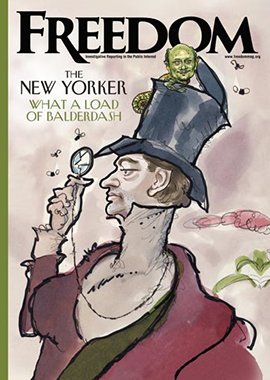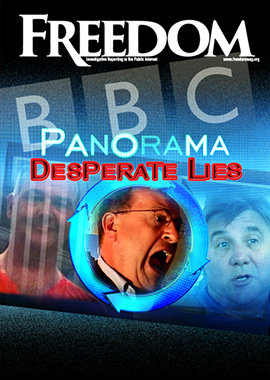Dr. Patrick Soon-Shiong, who bought the newspaper in 2018, explained in a recent interview that the paper had conflated news and opinion and vowed to take it in another direction where all voices are represented and heard.
“If it’s news, it should just be the facts, period,” Soon-Shiong said. “And if it’s an opinion, that’s maybe an opinion of the news, and that’s what I call now a voice. And so, we want voices from all sides to be heard, and we want the news to be just the facts.”
In a November 10 tweet, Soon-Shiong said he wants the paper to be “fair and balanced so that all voices are heard and we can respectfully exchange every American’s view … from left to right to the center. Coming soon. A new Editorial Board. Trust in media is critical for a strong democracy.”
“A little more than half of the journalists surveyed (55 percent) say that every side does not always deserve equal coverage in the news.”
Left unspoken is the reason for such a shift on the pages of the publication with the largest daily circulation of any metropolitan newspaper in the United States. Jeff Bezos, founder of Amazon and owner of The Washington Post, provided perspective. Bezos recently wrote an editorial for his newspaper in which he acknowledged a poll had ranked journalists and the media “the least trusted” profession of all.

“We must be accurate, and we must be believed to be accurate,” Bezos wrote. “It’s a bitter pill to swallow, but we are failing on the second requirement. Most people believe the media is biased. Anyone who doesn’t see this is paying scant attention to reality, and those who fight reality lose.”
While attempting to maintain the illusion of impartiality, the media has displayed that bias for years. The late Buddy Davis, a venerable journalism professor who towered over students and staff at the University of Florida School of Journalism, hinted at how that bias gets concealed.
“You always argue both sides of an issue,” Davis said with a wry smile while perched on the edge of his desk. “But you argue your side better.” Davis perfected that tactic, winning him the 1971 Pulitzer Prize for editorial writing in The Gainesville Sun.
But the landscape of journalism has changed drastically since then, and not for the better. The bias is no longer tamped down.
A shocking 2022 study by the Pew Research Center concluded, “A little more than half of the journalists surveyed (55 percent) say that every side does not always deserve equal coverage in the news.”
Such a finding would have deleted the smile clean off Buddy Davis’ face.
That slide from what had been a basic journalism principle—the duty to tell both sides of a story—has resulted in the steady erosion of public trust reflected in the poll above and Bezos’ editorial. It’s certainly impacted how most Americans rate the legacy press. And consolidation of media in the US has played its role.

“Just 37 years ago, there were 50 companies in charge of most American media,” writes Mira Nalbandian, editor-in-chief of Pathfinder. “Now, 90 percent of the media in the United States is controlled by just six corporations: AT&T, CBS, Comcast, Disney, Newscorp and Viacom.
“This means that just 232 media executives are calling the shots for the vast majority of the information we are presented with, controlling a total Big Six net worth of over $430 billion.”
This industry consolidation has allowed powerful companies to morph the media’s messaging. While still masquerading as impartial, the objective therefore shifted: The media’s purpose ceased being to inform. It became instead to persuade. And where once opinion had only been welcomed on Op-Ed pages, bias spilled off editorial pages and leaked across all content. Stories became propaganda. As Soon-Shiong said, media “has conflated news and opinion.” And with fewer competing voices, there was no competing view.
The media became an echo chamber.
A quick web search offers many lessons on the myriad disguises used to shield favoritism and practice the science of bias within this echo chamber. Take for example the lessons presented on the Metropolitan Community College website, which offers these time-tested methods of bending the message. Most of the below techniques were obvious during recent media coverage of political events:
- Bias by story selection. Bias by story selection occurs when a news outlet only runs stories that reflect a particular point of view.
- Bias by omission. A news story might present only one side of a story and omit facts or other details that support a different viewpoint. For instance, a newscaster might only interview liberal commentators or a website might only quote conservative sources.
- Bias by source selection. An article or news story might interview or reference more sources that support one view over another.
- Bias by commission. Bias by commission occurs when a news outlet or reporter passes along assumptions that tend to support one point of view or political party.
- Bias by placement or layout. A news editor can promote certain stories by featuring them prominently (on the front page or at the top of a website) while “burying” other stories that reflect another point of view. Television or radio stations might report the “favored” stories first and the less favored later in the broadcast.
- Bias by word choice or tone. The word choices a journalist makes or the tone a newscaster adopts can manipulate the public’s reaction to a news story. Loaded or sensational words can elicit a positive or negative emotional response. Examples include choosing the word infanticide over abortion or anti-choice over pro-life, or using the word gloat to describe a politician’s response to a news story.
- Bias by labeling. Labeling occurs when positive or negative labels are assigned to one group but not another (for example, “extreme right” or “far-left”).
- Bias by image selection. Flattering or unflattering photographs, images, or camera angles can also influence the public’s perception of a person or event. The images an editor or producer selects might reflect a bias.
The merging of fact and opinion from the legacy media reached such a massive crescendo it resonated with Americans, as evidenced by the Gallup poll reporting that a measly 31 percent of Americans said they had either “a great deal” or “a fair amount” of trust in the media’s ability to report the news “fully, accurately and fairly.”

Trust in journalism is due for a major overhaul. The legacy media has melted down and is now hemorrhaging readers and viewers. Smug in their brick-and-mortar aeries, the pundits and writers, cartoonists and editors continue to coalesce so much so that their preaching now only rings true for those in the choir.
The move by Soon-Shiong at the LA Times may be the start of rediscovering the core purpose of media: educating and informing the public. As Thomas Jefferson said, “No government ought to be without censors; and where the press is free no one ever will.”






















